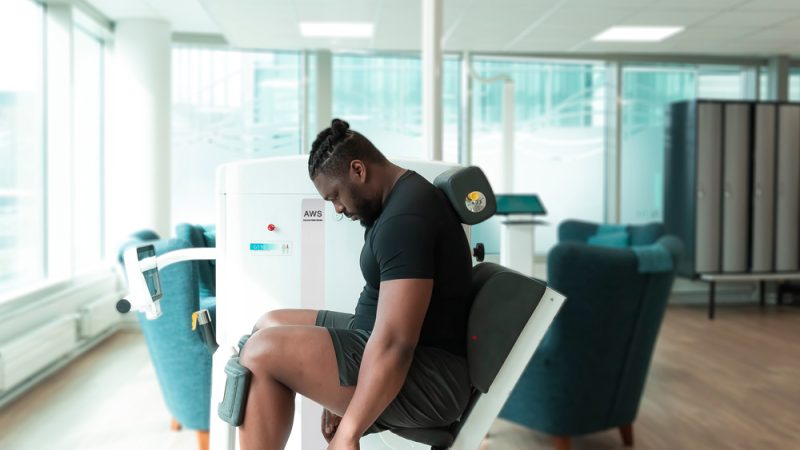This instability – a loss of control or excessive movement in the spinal segments – may be attributed to pain arising from trauma injury, facet joints, degenerative disks or muscular weakness (3, 4.) These factors affect an inhibitory feedback mechanism for localised deep Multifidus, leading to reflex inhibition of the Multifidus and ultimately, atrophy and fatty replacement of the muscle (5,6.) (Deconditioning). An acute episode of low back pain has been shown to immediately affect Multifidus muscle atrophy. As a result of pain inhibition from the spine, Multifidus atrophy tends to continue, and full recovery of the lost muscle mass is not seen even after pain has resolved (7). This lack of full spontaneous recovery of the Multifidus may contribute to the high recurrence rate of LBP. A magnetic resonance image (MRI) study of patients with chronic low back pain observed Multifidus muscle atrophy and fatty tissue deposits in 80% of patients (8).

The deep Multifidus muscles are vitally important stabilisers of the spinal vertebra.
Furthermore, the pattern of Multifidus atrophy is local rather than general. In a study comparing Multifidus size and bilateral symmetry in chronic LBP patients and healthy asymptomatic subjects (9.), asymptomatic subjects were found to have significantly larger Multifidus muscles. Asymmetry was also seen in patients with unilateral pain presentations.
A review by Russo et al discusses how the mechanism leading to Multifidus atrophy is closely related to arthrogenic muscle inhibition (3.) The mechanism involves pain in a skeletal joint causing reduced neural drive to the muscles that move or stabilise that joint. Various published studies using MRI and ultrasound have shown reduced neural drive to the Multifidus.
EMG and brain stimulus mapping studies of patients with acute or chronic LBP show altered recruitment of the Multifidus due to pain, pain avoidance and deconditioning (10,11.)
The switch had been turned ‘OFF’.
Specific, targeted and isolated exercise treatment restores the changed recruitment patterns in all three fibre layers of the Multifidus. These studies also reveal that in the chronic stage of back pain, when recovery of the Multifidus muscle may be hampered by changed recruitment patterns, other muscles (such as Erector Spinae) are active and substitute for the stabilising Multifidus muscles.

Specific, targeted and isolated exercise treatment with the DAVID Spine devices restores the changed recruitment patterns in all three fibre layers of the Multifidus.
The Multifidus has three layers of fibres stabilising the three planes of spinal movement. Specific exercise and isolated movement patterns are required to re-ignite or ‘Switch ON’ its recruitment patterns and restore the balance between the deep and superficial muscles.
The specific, targeted and isolated exercise treatment delivered by getback Therapists restore the changed recruitment patterns in all three fibre layers of the Multifidus. getback’s therapeutic exercise treatment re-enables the Multifidus’ vital function in stabilising spinal vertebra in the ‘neutral zone’ during our everyday, multi-directional movement patterns.
The Multifidus – recognised as a very difficult muscle to isolate and train – is effectively re-activated by the exercise treatment.
The switch can be turned back ON.
Overview of Switch ON to Switch OFF
- The spine stabilisation system consists of the vertebra, the deep muscles, and the neural control feedback system.
- Arthrogenic muscle inhibition can disrupt control to the spine’s key segmental stabilising muscle – the lumbar Multifidus.
- Disrupted muscle control can lead to compromised clinical stability of the spine, allowing joint overload and consequent persistent and recurrent pain.
- Re-establishing motor coordination, increased blood flow and focused strengthening and movement of the Multifidus to progressively increase the strength of the deep and superficial muscles supporting the spine.
Click on the button below to watch a video that explains the Multifidus in more detail:
References
- Panjabi, M.M. (1992) The Stabilizing System of the Spine, Part 1: Function, Dysfunction, Adaption and Enhancement. Journal of Spinal Disorders, 5, 383-389.
- Macintosh J, Valencia F, Bogduk M, Munro R. The morphology of the lumbar multifidus. Clin Biomech 1986;1:196-204.
- Russo M, Deckers K, Eldabe S et al. Muscle Control and Non-specific Chronic Low Back Pain. Neuromodulation. 2018 Jan;21(1):1
- Freeman MD, Woodham MA, Woodham AW. The role of the lumbar multifidus in chronic low back pain: a review. PMR. 2010 Feb;2(2):142-6; quiz 1 p following 167. doi: 10.1016/j.pmrj.2009.11.006. PMID: 20193941.
- Hides JA, Jull GA, Richardson CA. Long-term effects of specific stabilizing exercises for first-episode low back pain. Spine (Phila Pa 1976). 2001;26:E243-E248.
- Hides J, Gilmore C, Stanton W, Bohlscheid E. Multifidus size and symmetry among chronic LBP and healthy asymptomatic subjects. ManTher 2008;13:43
- Hides, Julie A. PhD; Richardson, Carolyn A. PhD; Jull, Gwendolen A. MPhty Multifidus Muscle Recovery Is Not Automatic After Resolution of Acute, First-Episode Low Back Pain. Spine, Volume 21(23).December 1, 1996.2763-2769
- Kjaer, P., Bendix, T., Sorensen, J.S., Korsholm, L. and Leboeuf-Yde, C. (2007) Are MRI-Defined Fat Infiltrations in the Multifidus Muscles Associated with Low Back Pain? BMC Medicine, 5, Article No. 2
- Hodges PW, Danneels L. Changes in Structure and Function of the Back Muscles in Low Back Pain: Different Time Points, Observations, and Mechanisms. J Orthop Sports Phys Ther. 2019 Jun;49(6):464-476. doi: 10.2519/jospt.2019.8827. PMID: 31151377
- MacDonald D, Moseley GL, Hodges PW. People with recurrent low back pain respond differently to trunk loading despite remission from symptoms. Spine (Phila Pa 1976). 2010;35:818-824.
- Brumagne S, Diers M, Danneels L, Moseley GL, Hodges PW. Neuroplasticity of Sensorimotor Control in Low Back Pain. J Orthop Sports Phys Ther. 2019 Jun;49(6):402-414. doi: 10.2519/jospt.2019.8489. PMID: 31151373
- Danneels L, Vanderstraeten G, Cambier D, et al. Effects of three different training modalities on the cross sectional area of the lumbar multifidus muscle in patients with chronic low back pain. Br J Sports Med 2001;35:186-191.
Disclaimer
This article was reprinted from our partner GetBack. You can read the original article back on GetBack website.
 English
English 
























